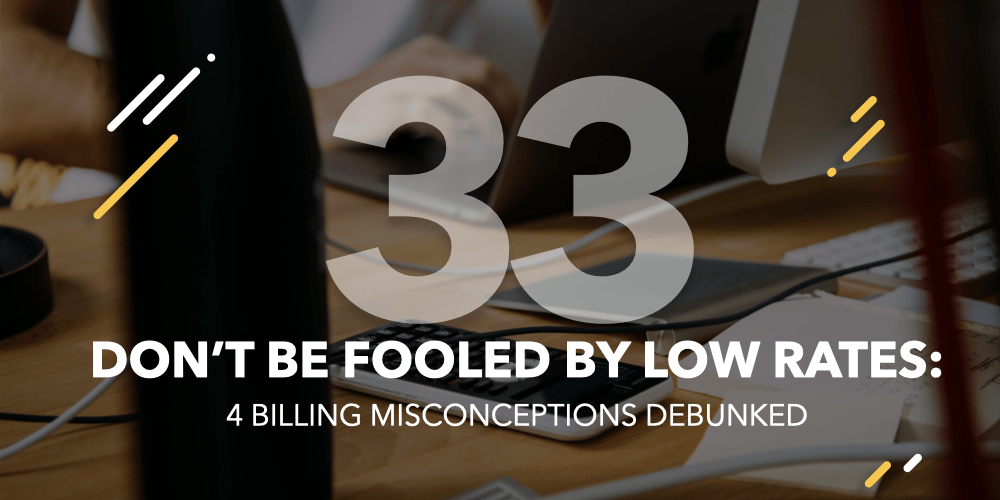Listen 🎧
Key Takeaways:
4 Common Bill Rate Misconceptions:
1. A low bill rate will result in a lower invoice from my labor provider.
This is not the case in the events industry. When outsourcing labor to a partner, it is challenging to find an invoice that accurately bills for what the crew actually worked.
2. The reconciliation process has no impact on your invoice.
The reconciliation process can significantly affect your invoice. It is important to review and audit your invoice in comparison to your estimate to ensure accuracy.
3. Billing rules are not significant in determining the cost of an invoice.
Make sure to compare the bill rules and not only the bill rate. For example, are both companies billing daily overtime or is one only billing for weekly overtime? Those can have big ramifications. Various states like California & Colorado, have different daily overtime requirements. But in addition to always being billed daily overtime, are they both rounding up to the next half hour or is only one billing for the time?
4. Your labor partner’s stance on compliance has no effect on your cost.
Some companies believe that they can outsource their liability when it comes to worker’s comp claims, wage claims, and misclassification by relying on their partner’s compliance with regulations, such as providing W-2 crew or 1099s. However, cutting corners in this area can come back to bite you.
Watch 📺
Read the Transcript 📚
[00:00:00] Angela Alea: Welcome to Corralling the Chaos Podcast, where we talk publicly about the things you’re worried about privately. My name is Angela Alea, and I’m your host. This is the event industry podcast for companies and crew where we’re gonna dive deep into things like, what does our industry need that it just doesn’t have?
[00:00:18] What are the things you want to know, but you’re just too afraid to ask? And what are the biggest opportunities ahead for our. We’re gonna go deep and nothing is off limits.
[00:00:36] Welcome back to Corralling The Chaos. Today I wan to talk about the expectation we should have when it comes to how we pay for certain services. It’s been fun to watch our industry evolve in some ways. And in others, we continue to just kind of accept things since that’s the way they’ve always been done.
[00:00:55] And today I want to challenge that thinking. So we, before we jump into the specific topic [00:01:00] today, I first want to ask you a scenario situation. If you realize you need gas in your car, you pull into the gas station and you pull in, you see it’s $3 a gallon, let’s say you. 18 point 12 gallons of gas. So that would mean it’s gonna cost you $54 and 36 cents to fill up your car with gas.
[00:01:21] My question for you is, did you end up paying for 20 gallons or the 18 point 12 that the pump said you actually used? Yes, of course You paid for 18 point 12 gallons, not the 20. Because that would be silly. Right? So you’re expecting to pay for what you used Right. That principle unfortunately doesn’t always apply in our industry, and I’m gonna challenge you all to look to find a labor invoice where you outsource labor to a partner where your build for what the crew actually worked.
[00:01:55] Yep. I’m talking about fractions of an hour. I’m in a real [00:02:00] fraction, something that ends in anything but a zero or a five. If you can find one of those, send it to. And I’ll pay you $500 because I don’t think it exists, and here’s why. That’s a problem. Let’s say you have a five day call, cause I want to quantify it for you all.
[00:02:18] Let’s just take one single show to kind of show you where these dollars are adding up. Let’s say you have a five day run, right? You need 20 people. Let’s say you’re being billed $40 an hour for straight time, which is $60 an hour in overtime, which is a dollar a minute. You kind of see where I’m going with this, right?
[00:02:34] So let’s say, just to keep it easy every day, the call ended at 7:12 PM. There are two things that are gonna happen. You’re either gonna be billed to seven 30 or to 8:00 PM You should check. Let’s check both scenarios and let’s quantify what each one means to you in dollars. Real dollars. If you are being billed until seven 30, that’s an extra 18 minutes for 20 people for five days at [00:03:00] straight time.
[00:03:00] That’s $1,200 extra. You’re paying for time. That’s just not worked. You didn’t get any benefit for those extra 18. Let’s pour some salt on that. Let’s assume you went with a company who’s also charging you daily over time instead of weekly over time. Now you’re paying daily, and if they’ve already worked past the 10 hours each day, you’re now paying $1,800 for time that they didn’t work right, because the call wrapped at seven 12.
[00:03:30] Now let’s look at a different scenario. Now let’s examine if that company rounds to the next hour, which many do, meaning they’re gonna round up to just 8:00 PM Hey, the call is roughly in around eight. If that same scenario was rounded up to 8:00 PM that’s over $3,200 you paid. And if they’re an overtime, you’re gonna overpay by almost $5,000, $4,800 to be.
[00:03:56] But hey, your bill rate was only 40. So you got is what we say in my [00:04:00] family bamboozled and so did the crew. Because if you’re paying a low bill rate, the crew is getting an even lower pay rate. So the lesson here is don’t be fooled by lower bill rates. You’ve gotta examine more beyond that. Here’s what I mean by that.
[00:04:17] There’s kind of four different areas that you should be examine In the partnerships that you have, so there’s more four kind of misconceptions. The first one is a low bill rate does not mean a lower invoice, which we just talked about. So the first one obviously is the bill rate, but don’t be fooled by the shiny lower bill rate.
[00:04:36] It does not always mean a lower overall cost. The second thing that affects your invoice is the reconciliation process. I strongly recommend you audit your invoice compared to your estimate. For example, one thing we see quite often is a company will request 13 people to work the load in and the load out on an event.
[00:04:56] Fast forwards the events over. The bill shows up and it has [00:05:00] 17 people on it. Of course, you’re left assuming we must have asked for more to get the work done. Okay, let’s pay it and keep moving. What’s typically happened, Is instead that the labor company overbooked crew to account for any no-shows that may occur, which, hey, that is a great thing.
[00:05:16] That is a sign of a good partner, right? They want to make sure you’re covered. So, hey, if they need 13 and in light of what’s happening sometimes in the industry, we’re gonna overbook by four. That’s a great thing. Good intentions there. However, when everyone shows up, you get stuck paying for the extra four people.
[00:05:33] This happens all the. So you’re overpaying there. The third thing that is the biggest culprit to higher invoices are all of the bill rules. You must make sure you compare the bill rules and not only the bill rate. So here’s what I mean by that. For example, are both companies billing daily overtime or is one only billing for weekly overtime?
[00:05:55] Those can have big ramifications. Obviously in states like California, [00:06:00] Colorado, each of those have different daily overtime requirements, so that just kind of is what it is. But in addition to always being billed daily overtime, are they both rounding up to the next half hour or is only one billing for the time?
[00:06:13] They actually worked to the minute, a fraction of an. The thing that affects your pricing is your partner’s stance on compliance. Are they providing W-2 crew or 1099s? Do not cut corners here, please. It will come back to bite you. When it comes to worker’s comp claims, wage claims, misclassification, all sorts of things, many companies think that they can outsource their liability when it comes to this thinking, well, I didn’t hire them.
[00:06:46] My partner. Wrong. You carry that liability. Unfortunately, the Department of Labor does not look at it that way. We’re actually gonna have them on a future podcast in a few weeks where you can hear straight from them. For example, if God [00:07:00] forbid, somebody gets injured on the job. Workers’ comp is gonna come after your labor partner.
[00:07:05] They’re gonna come after you, and yeah, they’re coming after your client. The end client will pay more for talent that is compliant and leaves them protected. We’re seeing more and more in service agreements. Companies are actually requiring that only W-2 crew are on their show site. So time is running out for companies that are still issuing 1099.
[00:07:27] The tides of turn and misclassification, it’s not going away. When you hire a labor agency, make sure you’re asking and getting in writing that they’re not only sending fully insured crew, but they’re sending fully insured W-2 crew. Because being fully insured as a 1099 does not make them compliant.
[00:07:45] The reality is there’s stiff penalties for misclassifying your people because you know who suffers the crew, they don’t have access to state unemployment. Other benefits. Other things that just come along with being an employee, not to mention they’re paying double the [00:08:00] amount in taxes. So again, protect yourself, your company, and your client by checking the box and making sure your A, your Labor agency is issuing W-2s.
[00:08:10] It’s just not enough to say yes, they are insured. So as you can see, there are a lot of things that impact your final invoice. Do your due diligence go beyond the bill? Inspect the bill rules, the final invoice compared to your estimate. And lastly, make sure you’re bringing W-2 Crew to your show site.
[00:08:28] Don’t be caught being fooled by a lower bill rate at Lasso. It’s funny, we always catch people off guard by saying right out of the gate, our bill rates are higher than you can find anywhere else, period. But, but. Your invoice will almost always be lower. So look at partners who have full transparency.
[00:08:48] They’re simplifying that for you. They’re driving quality people with a lower invoice. Because yes that can be done. You can have both. You can have crew who are paid top [00:09:00] dollar in the market while still having, a lower invoice. So keep that in mind. You really can’t have both of those. Oh, and let’s not. You get what you pay for.
[00:09:10] So if you have low bill rates, chances are you aren’t getting top talent because if you’re paying a lower bill rate, that typically means they’re paying their crew a lower amount. And to attract great people, you gotta pay ’em well. And that’s a risk no one, no one can really afford to take. So as we wrap up, I encourage you to look beyond the bill rates.
[00:09:28] Take the time to audit what you’re really paying for. Don’t be bamboozled by a low pay rate. Look beyond that. Look at what your total invoice is gonna. So thanks for tuning in today. If you like what you hear, be sure to subscribe and please reach out with any comments or feedback to podcast@lasso.io.





